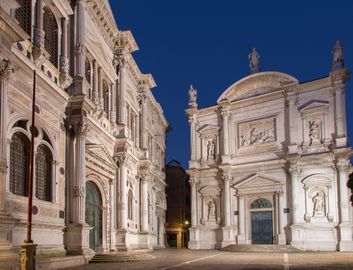

The Church of Saint Roch was built at the turn of the 16th century by Bartolomeo Bon the Younger, only to be modified more than two hundred years later. Its façade was erected in 1771 by Bernardino Maccarucci, a little less than thirty years before the fall of the Venetian Republic. Not only is this shrine considered one of the Venetian plague-churches, that is, a church built in honor of those who succumbed to the fatal disease, it contains the remains of the protector from the plague himself, St Roch.
Roch was born in Montpellier, in present-day Southern France, in 1348. His family belonged to the local nobility and his mother was barren until she prayed to the Virgin Mary. Miraculously the boy was not only born, but was born with a red cross on his chest. He began manifesting signs of piety, and even asceticism, at a very tender age, fasting more than was normal. Although Roch's father had prepared a lucrative political career for him, when his parents died, the twenty-year-old distributed all his goods among the poor and embarked upon a pilgrimage to Rome. He arrived in the Eternal City during the outbreak of the plague and devoted a lot of time and energy praying for the sick. Supposedly his prayers saved numerous people. He then moved up north and while he was ministering in Piacenza, he caught the plague himself. Consequently, he was banished from the town and hid in a forest where a dog brought him bread and licked his wounds. The dog's owner, Count Gothard, once followed it into the forest and discovered Roch. The two men formed a friendship and Roch gained his first follower. Upon entering the town of Voghera, Roch was arrested as a spy and imprisoned. He died five years later in 1379, still in confinement. He had never revealed his real name. But soon people, having heard of Roch's miraculous cures, recognized him by his birthmark and began venerating him. His fame quickly spread throughout Northern and Central Italy, France, Spain and Germany. In 1485 his remains were translated to Venice, where the local authorities immediately began petitioning the Vatican for his canonization. However, he was canonized only in 1591 by Pope Gregory XIV, who fixed the saint's feast day on August 16, the day of his death. Today St Roch is also the patron saint of bachelors, diseased cattle, dogs, invalids, falsely accused people gravediggers, pilgrims and apothecaries.
The interior of the Church of St Roch is decorated by several admirable works of art, in which the saint is usually portrayed with a lesion on his leg. We find a statue of the saint by Bartolomeo Bon; two paintings by Pordenone - St Martin and St Christopher; two paintings by Sebastiano Ricci - St Helen finds the wood of the Cross and St Francis of Paola revives a baby; as well as a cycle illustrating various episodes from the saint's life by Jacopo Tintoretto. Yet, Tintoretto's most fascinating works dedicated to St Roch are located in the building next to the church, la Scuola Grande di San Rocco.